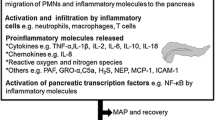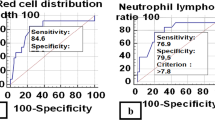Abstract
The aim of our study was to observe the dynamic changes of immunity for patients with severe acute pancreatitis (SAP) and intervention by traditional Chinese medicine. Twenty-three patients who met the inclusion criteria were randomized to combined treatment of traditional Chinese medicine and Western medicine (TCM) or conventional western medicine treatment (WM) groups. The clinical data for all patients were collected. Peripheral venous blood samples were obtained from patients on days 1, 7, 14, and 28 after admission. Biochemical data including the percentage of CD4+/CD8+/natural killer (NK) cells/B lymphocytes/HLA-DR and CD4+/CD8+ ratio in serum were determined by flow cytometer. Patients’ characteristics and immunity at admission were similar between the two groups. The secondary infection was different. The levels of T-lymphocyte subsets in the TCM group were quite different from the WM group, with much more the percentage of CD4+ and the CD4+/CD8+ ratio on days 7, 14, and 28 and much less the percentage of CD8+ on days 14 and 28. On days 14 and 28, the levels of NK cells and B lymphocytes were significantly higher in the TCM group compared with the controls. Compared with the TCM group, the levels of HLA-DR were significantly decreased in the WM group on days 7, 14, and 28. The immune dysregulation exists in the development and progression of SAP. The combined treatment of traditional Chinese medicine and western medicine can upregulate the patient’s immune and maintain the immune balance.
Similar content being viewed by others
References
Bumbasirevic, V., D. Radenkovic, Z. Jankovic, et al. 2009. Severe acute pancreatitis: Overall and early versus late mortality in intensive care units. Pancreas 38: 122–125.
Appelros, S., S. Lindgren, and A. Borgström. 2001. Short and long term outcome of severe acute pancreatitis. The European Journal of Surgery 167: 281–286.
Tang, W.F., Y.G. Wang, L. Zhu, et al. 2007. Effect of somatostatin on immune inflammatory response in patients with severe acute pancreatitis. Journal of Digestive Diseases 8: 96–102.
Zhang, X.P., H.Q. Chen, F. Liu, et al. 2009. Advances in researches on the immune dysregulation and therapy of severe acute pancreatitis. Journal of Zhejiang University. Science B 10: 493–498.
de Beaux, A.C., J.A. Ross, J.P. Maingay, et al. 1996. Proinflammatory cytokine release by peripheral blood mononuclear cells from patients with acute pancreatitis. The British Journal of Surgery 83: 1071–1075.
Widdison, A.L., and S. Cunningham. 1996. Immune function early in acute pancreatitis. The British Journal of Surgery 83: 633–636.
Feili, G. 2004. Medical immunology. Beijing: Scientific.
Takeyama, Y. 2005. Significance of apoptotic cell death in systemic complications with severe acute pancreatitis. Journal of Gastroenterology 40: 1–10.
Tellado, J.M. 2007. Prevention of infection following severe acute pancreatitis. Current Opinion in Critical Care 13: 416–420.
Takeyama, Y., K. Takas, T. Ueda, et al. 2000. Peripheral lymphocyte reduction in severe acute pancreatitis is caused by apoptotic cell death. Journal of Gastrointestinal Surgery 4: 379–387.
Bradley 3rd, E.L. 1993. A clinically based classification system for acute pancreatitis: summary of the International Symposium on Acute Pancreatitis, Atlanta, Ga, September 11 through 13, 1992. Archives of Surgery 128: 586–590.
UK Working Party on Acute Pancreatitis. 2005. UK guidelines for the management of acute pancreatitis. Gut 54: iii1–iii9.
Gravante, G., G. Garcea, S.L. Ong, et al. 2009. Prediction of mortality in acute pancreatitis: A systematic review of the published evidence. Pancreatology 9: 601–614.
Balthazar, E.J. 2002. Acute pancreatitis: Assessment of severity with clinical and CT evaluation. Radiology 223: 603–613.
Eckerwall, G.E., J.B. Axelsson, and R.G. Andersson. 2006. Early nasogastric feeding in predicted severe acute pancreatitis: A clinical, randomized study. Annals of Surgery 244: 959–965.
Mofidi, R., M.D. Duff, S.J. Wigmore, et al. 2006. Association between early systemic inflammatory response, severity of multiorgan dysfunction and death in acute pancreatitis. The British Journal of Surgery 93: 738–344.
Norman, J. 1998. The role of cytokines in the pathogenesis of acute pancreatitis. American Journal of Surgery 175: 76–83.
Yubero, S., L. Ramudo, M.A. Manso, et al. 2009. Targeting peripheral immune response reduces the severity of necrotizing acute pancreatitis. Critical Care Medicine 37: 240–245.
Beger, H.G., and B.M. Rau. 2007. Severe acute pancreatitis: clinical course and management. World Journal of Gastroenterology 13: 5043–5051.
Shi, C.B., X. Zhao, A. Lagergren, et al. 2006. Immune status and inflammatory response differ locally and systemically in severe acute pancreatitis. Scandinavian Journal of Gastroenterology 41: 472–480.
Bone, R. 1996. Toward a theory regarding the pathogenesis of the systemic inflammatory response syndrome: What we do and what we do not know about cytokine regulation. Critical Care Medicine 24: 163–172.
Rahman, S.H., A.M. James, B. Ammori, et al. 2002. Ischaemia-reperfusion injury, gut macromolecular permeability and severe acute pancreatitis. The British Journal of Surgery 89: 34–34.
Ammori, B.J., P.C. Leeder, R.F. King, et al. 1999. Early increase in intestinal permeability in patients with severe acute pancreatitis: Correlation with endotoxemia, organ failure, and mortality. Journal of Gastrointestinal Surgery 3: 252–262.
Rahman, S.H., G. Salter, J.H. Holmfield, et al. 2004. Soluble CD14 receptor expression and monocyte heterogeneity but not the C-260T CD14 genotype are associated with severe acute pancreatitis. Critical Care Medicine 32: 2457–2463.
Monneret, G., F. Venet, A. Pachot, et al. 2008. Monitoring immune dysfunctions in the septic patient: A new skin for the old ceremony. Molecular Medicine 14: 64–78.
Tsui, N.C., E. Zhao, Z. Li, et al. 2009. Microbiological findings in secondary infection of severe acute pancreatitis: A retrospective clinical study. Pancreas 38: 499–502.
Uehara, S., K. Gothoh, H. Handa, et al. 2003. Immune function in patients with acute pancreatitis. Journal of Gastroenterology and Hepatology 18: 363–370.
Marshall, J.C., N.V. Christou, and J.L. Meakins. 1993. The gastrointestinal tract: The ‘undrained abscess’ of multiple organ failure. Annals of Surgery 218: 111–119.
Liu, H.B., N.Q. Cui, Q. Wang, D.H. Li, and X.P. Xue. 2008. Sphingosine-1-phosphate and its analogue FTY720 diminish acute pulmonary injury in rats with acute necrotizing pancreatitis. Pancreas 36: e10–e15.
Liu, H., W. Li, X. Wang, J. Li, and W. Yu. 2008. Early gut mucosal dysfunction in patients with acute pancreatitis. Pancreas 36: 192–196.
Xia, Q., J.M. Jiang, X. Gong, et al. 2000. Experimental study of Tong Xia purgative method in ameliorating lung injury in acute necrotizing pancreatitis. World Journal of Gastroenterology 6: 115–118.
Gong, H.L., W.F. Tang, Q. Yu, et al. 2009. Effect of severe acute pancreatitis on pharmacokinetics of Da-Cheng-Qi Decoction components. World Journal of Gastroenterology 15: 5992–5999.
Qiu, Y., Y.Y. Li, S.G. Li, et al. 2004. Effect of Qingyitang on activity of intracellular Ca2+-Mg2+-ATPase in rats with acute pancreatitis. World Journal of Gastroenterology 10: 100–104.
Ammori, B.J. 2003. Role of the gut in the course of severe acute pancreatitis. Pancreas 26: 122–129.
Curley, P.J., M.J. McMahon, F. Lancaster, et al. 1993. Reduction in circulating levels of CD4-positive lymphocytes in acute pancreatitis: Relationship to endotoxin, interleukin-6 and disease severity. The British Journal of Surgery 80: 1312–1315.
Yao, W., Q. Zhu, Y. Yuan, et al. 2007. Thymosin alpha 1 improves severe acute pancreatitis in rats via regulation of peripheral T cell number and cytokine serum level. Journal of Gastroenterology and Hepatology 22: 1866–1871.
Tonegawa, S. 1988. Antibody and T-cell receptors. JAMA 259: 1845–1847.
Ho, Y.P., I.S. Sheen, C.T. Chiu, et al. 2006. A strong association between down-regulation of HLA-DR expression and the late mortality in patients with severe acute pancreatitis. The American Journal of Gastroenterology 101: 1117–1124.
Kylanpaa, M.L., P. Mentula, E. Kemppainen, et al. 2005. Monocyte anergy is present in patients with severe acute pancreatitis and is significantly alleviated by granulocyte-macrophage colony-stimulating factor and interferon-gamma in vitro. Pancreas 31: 23–27.
DiMagno, M.J., and E.P. DiMagno. 2007. New advances in acute pancreatitis. Current Opinion in Gastroenterology 23: 494–501.
Frossard, J.L., M.L. Steer, and C.M. Pastor. 2008. Acute pancreatitis. Lancet 371: 143–152.
Acknowledgment
This work was supported by the National Science and Technology Support Program of China (grant no. 2006BAI04A15).
Author information
Authors and Affiliations
Corresponding author
Rights and permissions
About this article
Cite this article
Liu, Z., Shen, Y., Cui, N. et al. Clinical Observation of Immunity for Severe Acute Pancreatitis. Inflammation 34, 426–431 (2011). https://doi.org/10.1007/s10753-010-9249-5
Published:
Issue Date:
DOI: https://doi.org/10.1007/s10753-010-9249-5




